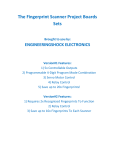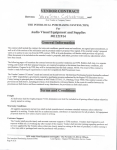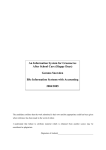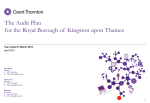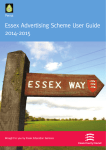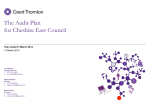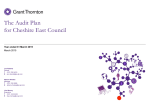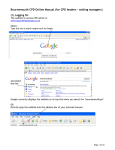Download Wellbeing questionnaire User Guide for Schools
Transcript
Wellbeing questionnaire User Guide for Schools Please read this information carefully before completing the online questionnaire. Version 1.2 (September 2014) Designed and Developed for NCB by Schnell Solutions Ltd. Contents Description Page No. 1. Introduction 3 2. School Registration 5 3. School Login 6 4. Parent/Carer Consent 6 5. Maintain Pupil Data 7 6. Number of Collections 11 7. Reports 13 8. Profile 14 9. Help 14 10. Supporting Pupils to Access the Questionnaire 14 11. What will ABA do with the collection results? 15 12. Is the site secure? 15 13. Wellbeing Questionnaire – Question List 16 © SCHNELL SOLUTIONS LIMITED 2014 All rights reserved. No part of this publication may be reproduced, transmitted, transcribed, or translated into any language or computer language, in any form or by any means without prior express, written consent of: Schnell Solutions Limited E-mail: [email protected] Designed and Developed for NCB by Schnell Solutions Ltd. 1. Introduction The Anti-Bullying Alliance (ABA) is delivering a Department for Education funded programme from 2013 to 2015 in order to reduce bullying in schools for children with special education needs and/or disabilities (SEND). As part of this programme Achievement for All has been delivering training in schools on behalf of the Anti-Bullying Alliance. You can find out more about this programme via our website www.antibullyingalliance.org.uk/send-programme. In order to measure the impact of the training delivered in schools the Anti-bullying Alliance wants to hear directly from young people in schools. We have developed a set of indicators which are structured into 33 questions with 3-4 possible answers for each. This questionnaire is developed online and presented to the pupils to be filled in a confidential, safe and secure manner via an online portal. The purpose of the questionnaire is two fold: To ascertain the wellbeing of pupils and the levels of bullying and to be able to compare those with and without SEND in schools. To ascertain the success of ABA’s SEND programme. The purpose of this document is to act as a reference guide for schools on how to access and use the online portal. Before registering and using this portal, schools are required to seek permission from their head teacher and be involved in receiving training as part of this programme. If you are not sure or have any questions about using this portal, please contact the AntiBullying Alliance team at [email protected]. The questionnaire should be completed by schools before or just after they have received training. IMPORANT: If your school has not completed or are not registered to attend the training sessions delivered by Achievement for All then you are not able to use this online questionnaire. It should` then be completed again after the school introduces interventions to reduce the bullying of pupils with SEN/disabilities – we suggest approximately 3-4 months after. The 8 step process: We have tried to make this process as simple as possible whilst still collecting the information needed to accurately and safely assess wellbeing and bullying in schools. 1. School decides to complete the questionnaire for all pupils in year groups 4, 6, 8, 10 (depending on school type). 2. School registers on the online platform, with the head teacher’s approval, to complete the questionnaire Designed and developed for the Anti-Bullying Alliance, which is based at the National Children’s Bureau, by Schnell Solutions Ltd. Page 3 of 16 3. School obtains consent from parents 4. School uploads information about pupils they’d like to complete the questionnaire via an excel spreadsheet to the online platform. Information needed includes names, year group, SEN status, class/tutor group and gender. 5. This data generates a unique code for each pupil which they will then need to complete the questionnaire – these codes can be split by class group and produced on a sheet that can be printed and given/emailed to teachers and/or pupils. 6. Pupils are given support to understand the process and to give informed consent. Each pupil receives their code – logs in, gives consent and completes the questionnaire. 7. Once at least 20 pupils have completed the process (this is to ensure that schools cannot identify individual pupils’ answers) schools can start generating anonymous reports based on this data. 8. The process is repeated again after intervention (we recommend at least 3 months. ABA will use the data from all schools to show the success of the programme – however we will never identify your school’s data. You will be able to create an anonymous report for your school to use. You may want to use the data to report back to pupils, school staff, parents and carers, school governors, your local authority and to use in Ofsted inspections. Designed and developed for the Anti-Bullying Alliance, which is based at the National Children’s Bureau, by Schnell Solutions Ltd. Page 4 of 16 2. School Registration A member of school staff is required to submit the online School Registration form before their school can start to participate in the programme. The registration form can be accessed via http://www.myssapp.com/ncb/school and clicking on the ‘Not yet registered’ link. Designed and developed for the Anti-Bullying Alliance, which is based at the National Children’s Bureau, by Schnell Solutions Ltd. Page 5 of 16 At the time of registering, please provide all details as required and make sure you have the head teacher's approval and have attended or are about to attend the Achievement for All anti-bullying training course being delivered as part of the project led and managed by ABA. Only one user per school should register with this service. Once the registration form is submitted an email will be sent to you. You can now start to use the online portal. 3. School Login Once the registration form is submitted, the school will have immediate access to the portal which can be accessed via http://www.myssapp.com/ncb/school If the user has forgotten their password, they can use the 'Forgot Password?' link, and follow the instructions to reset their password. 4. Parent / Carer Consent Schools are responsible for obtaining consent from parents and carers. This can be done via an ‘opt-out’ system. You can find a template letter in the ‘Help’ section of the portal which can be filled in and given to each parent/carer of a pupil. It will explain the questionnaire process, information about the data involved and state that they have a set amount of time to respond if they do not want their child to take part in the survey. We recommend giving at least two weeks for parents and carers to respond to this letter. When a school registers to deliver the online questionnaire they will need to state that Designed and developed for the Anti-Bullying Alliance, which is based at the National Children’s Bureau, by Schnell Solutions Ltd. Page 6 of 16 they have consent from parents/carers to complete this before pupils will be able to fill in the questionnaire. 5. Maintain Pupil Data Once the user is logged in, they are presented with the default screen to maintain the pupil data. There is also a menu on the top to navigate to the various sections within the portal. The ‘Pupils’ screen is used to add/delete/edit data of the pupils whose parents/carers have signed the consent form to allow their child(ren) to take part in the programme. To make it easier to upload pupil data, schools can access a template Excel spreadsheet where they can input pupil data and upload the details of those pupils they would like to complete the questionnaire. This spreadsheet be downloaded in the 'Help' section. Please refer to the 'Help' section from the top menu bar in the portal for more details. Once all the pupil data is entered into the Excel template, the user can follow the steps below to import the data into the portal. Step 1: Click the Import button Step 2: Browse and upload the excel data Click on the ‘browse’ button and select the Excel file which contains the pupil data. Once selected, press the Upload button. Designed and developed for the Anti-Bullying Alliance, which is based at the National Children’s Bureau, by Schnell Solutions Ltd. Page 7 of 16 Step 3: Check and validate data As part of the import process, the uploaded data is checked and validated for any errors and repetition. This is presented to the user in a colour coded legend to help take the appropriate steps. Pupils for whom parents consent is not received will also be highlighted in RED and these records will not be imported. Once the user is happy with the information shown on the screen, the Save button will upload the pupil data into the portal. Designed and developed for the Anti-Bullying Alliance, which is based at the National Children’s Bureau, by Schnell Solutions Ltd. Page 8 of 16 Step 4: Generate Pupil Questionnaire Access Key: Before a pupil can complete a questionnaire, they need to be given a 6 character access key and the link to the portal which will allow them to access and complete the online questionnaire. In order to generate the access key, the user has to select the appropriate pupils using the 'Select' column and press the 'Generate Key' button. To make it easier to select the right pupils, search filter options can be used to shorten the pupils list displayed on screen. The portal provides three options for sharing the access key with the pupil: Sending email directly to pupil(s): Once the Pupil key has been generated, the system allows the user to send an email to pupil(s) which will contain their access key and the URL for the online questionnaire using the 'Send Pupil email' button. Sending email to class teacher(s): Once the Pupil key has been generated, the system allows the user to send an email to the respective teacher(s) along with a PDF which will contain the access key for each of their pupil using the 'Send Teacher Email' button. Designed and developed for the Anti-Bullying Alliance, which is based at the National Children’s Bureau, by Schnell Solutions Ltd. Page 9 of 16 The teacher is then expected to print the PDF and distribute the access keys accordingly. Print: If no email addresses are specified for pupils or teachers in the imported Excel spreadsheet, the user can print the access keys directly via the portal. This can be achieved by selecting the appropriate pupil(s) and using the Print button. Once clicked, the system will display a PDF document which the user can use for printing. Please note the access keys are confidential and pupil specific. Hence care should be taken at the time of printing and distributing the keys. If for any reason a parent/carer or pupil withdraws their consent, the school is expected to delete the pupil(s) accordingly. Upon deletion, all answers submitted by the pupil(s) complete or partial would be permanently deleted from the system. 6. Number of Collections & Version Management Version management is designed to help schools to complete the questionnaire more than once by collecting and grouping data from pupils into sets (versions) and then comparing the same to monitor and compare results/progress. There is no limit on the number of version a school can create for comparison. Example 1: A school which at the time of registration has already undergone the Anti-Bullying SEN/disabilities training can use the version management to collect data from pupils more than once and then compare the results. This can be useful to compare the impact of schools’ implemented interventions had over a period of time. How to use version management? Regardless of when the school has received the Anti-Bulling SEN/disabilities training, all schools can create a new version (i.e. start a new collection of the questionnaire) by using the 'Change Version' button. Creating a new version is very similar to starting the questionnaire again. Using this button has the following impact: • • • The current version number is automatically incremented by 1 All existing pupil access keys would become invalid i.e. pupils will not be able to complete the questionnaire All data collected up to this point will be stored in the database and will be labelled as 'current version - 1' Designed and developed for the Anti-Bullying Alliance, which is based at the National Children’s Bureau, by Schnell Solutions Ltd. Page 10 of 16 Schools will need to re-import pupil data and re-generate pupil access keys. Once the pupils have completed the online questionnaire using the access keys for the current version, schools can then compare the data between versions to access the impact on training and implemented policies and procedures over a set time period. Training date: Training date field should be used to record the date on which the school received the Anti-Bulling SEN/disabilities training. The date entered here is then used by the AntiBullying Alliance to compare data across schools nationally. What if I want to re-set all data? I would like to start fresh? Please use the Reset All Data button. This button is designed to delete all data of imported pupils, their questionnaire access keys, submitted questionnaire data, etc. Please note that once used, deleted data cannot be retrieved as all data is deleted permanently. Designed and developed for the Anti-Bullying Alliance, which is based at the National Children’s Bureau, by Schnell Solutions Ltd. Page 11 of 16 Designed and developed for the Anti-Bullying Alliance, which is based at the National Children’s Bureau, by Schnell Solutions Ltd. Page 12 of 16 7. Reports This section allows the schools to view reports on how their school is performing. There are three types of reports: Submission Report: This is a simple text based report which shows the school how many pupils have completed the questionnaire, how many are incomplete and how many have not started the questionnaire yet. Answer Report: This report is only available after at least 20 pupils from the school have submitted the questionnaire – this is to ensure that pupil submissions are not identifiable. The school also has the option to filter the data for a particular year group. When a year group is selected, the system will show the report only if questionnaire is submitted by at least 5 pupils from that year group. Answer Report (all questions): This report is same as the answer report but contains graphs and data for all questions. Its main purpose is to allow schools to print this report using the standard browser print functionality. Designed and developed for the Anti-Bullying Alliance, which is based at the National Children’s Bureau, by Schnell Solutions Ltd. Page 13 of 16 8. Profile This module is mainly used by school user to maintain their user details and reset their password. 9. Help The help module has useful links and documents for the school to refer to. It also contains a 'Demo' link which the school can use to test the questionnaire as pupils. While using the demo link no data is stored. If the school has any questions, which is not covered by this guide please send an email to [email protected]. 10. Supporting Pupils to Access the Questionnaire Pupil consent Pupils will give their consent (or not) online before completing the questionnaire. Information is provided to them about the process and they are then able to select whether they consent or not. Withdrawal of consent during the process If at any point in the process a pupil or their parent/carer wants to withdraw their consent for their answers to contribute to the data for their schools they can do so. Safeguarding pupils We will be asking pupils questions that may be difficult and possibly upsetting to answer. As this questionnaire is anonymous ABA won’t be able to identify those pupils that may be experiencing bullying or may be unhappy at school. It is important we are clear with pupils that by filling in the questionnaire they are not reporting bullying incidents nor are they highlighting any wellbeing issues. They should not expect a response. Important: Although we make it clear throughout the questionnaire that this is the case schools must communicate this to pupils and ensure that there is an appropriate adult to talk to if they need to. Supporting pupils with SEND to complete the questionnaire This questionnaire has been tested in both primary and secondary school and with pupils with SEND. We have ensured that we have kept the language as easy to understand as possible. Our online platform also has audio accompaniment for those who need/would like it. It is possible to change the background colours and colour of text. It is compatible with most screen reader software. Designed and developed for the Anti-Bullying Alliance, which is based at the National Children’s Bureau, by Schnell Solutions Ltd. Page 14 of 16 Some pupils may need to be supported to answer the questions and to understand what the questionnaire involves. However, it is important that schools do not influence pupils’ answers and that responses are confidential. 11. What Will ABA Do wWth the Collection Results? We will never share identifiable data about schools with anyone outside ABA unless we have the school’s written permission. We will collate anonymous data about schools and feed this back to the Department for Education (DfE). We will never release details about individual pupil responses. You will be able to create an anonymous report for your school to use. You may want to use the data to report back to pupils, school staff, parents and carers, school governors, your local authority and to use in Ofsted inspections. 12. Is the Site Secure? The collection and sharing of data will be carried out under the principles of the Data Protection Act (1998). We have ensured that we collect as little identifiable information about pupils as we can. We will not hold identifiable data any longer than we need to. All personally identifiable information collected is automatically encrypted and stored on our secure servers. The information exchanged between your browser and the server is also encrypted using SSL. Once the programme reaches its natural end, all data will be taken offline and handed over to the Anti-Bullying Alliance in an anonymous format. Designed and developed for the Anti-Bullying Alliance, which is based at the National Children’s Bureau, by Schnell Solutions Ltd. Page 15 of 16 13. Wellbeing Questionnaire – List of Questions Below is a list of the questions which will be asked of your pupils. This list has been developed after reviews of existing questionnaires and after piloting with young people. For more information please contact Martha Evans at [email protected]. Never I like going to school □ Other pupils tease me □ I am hit, pushed or kicked by other pupils □ Other pupils stop me from joining in during lunch □ and break time Other pupils say bad things about me when I’m not □ there I get on well with my teachers □ Other pupils don’t like me □ Other pupils stop me from joining in classroom □ activities Other pupils pick on me because I am a bit □ different I am called mean names by other pupils □ I feel safe at school □ I say bad things about other pupils when they □ aren’t there I hit, push or kick other pupils □ I pick on other pupils □ I feel like I belong at school □ I call other pupils mean names □ I tease other pupils □ I feel lonely I cry a lot I am unhappy Nobody likes me I worry a lot I have problems sleeping I wake up in the night I am shy I feel scared I worry when I am at school I get very angry I lose my temper I hit out when I am angry I do things to hurt people I am calm I break things on purpose Never □ □ □ □ □ □ □ □ □ □ □ □ □ □ □ □ A little □ □ □ □ A lot □ □ □ □ Always □ □ □ □ □ □ □ □ □ □ □ □ □ □ □ □ □ □ □ □ □ □ □ □ □ □ □ □ □ □ □ □ □ □ □ □ □ □ □ □ □ □ □ Sometimes □ □ □ □ □ □ □ □ □ □ □ □ □ □ □ □ Always □ □ □ □ □ □ □ □ □ □ □ □ □ □ □ □ Designed and developed for the Anti-Bullying Alliance, which is based at the National Children’s Bureau, by Schnell Solutions Ltd. Page 16 of 16
















